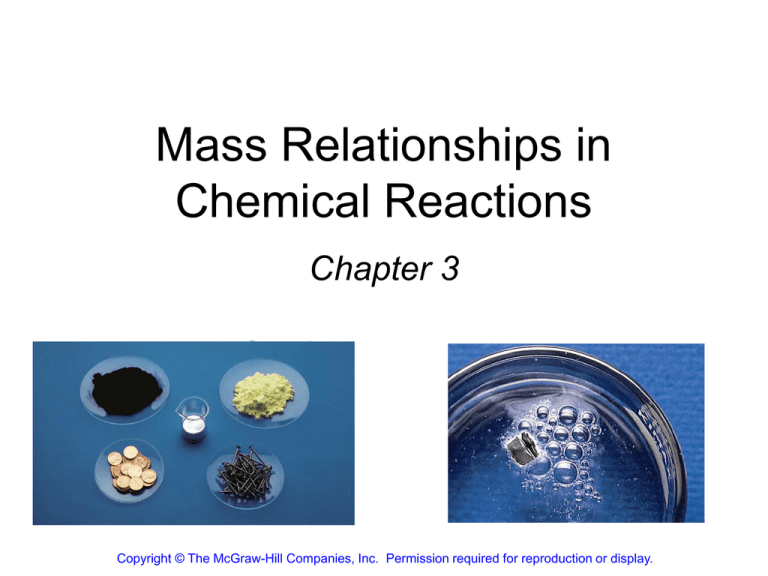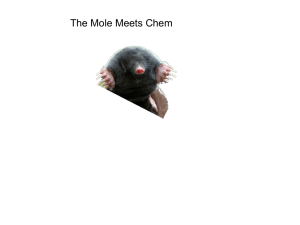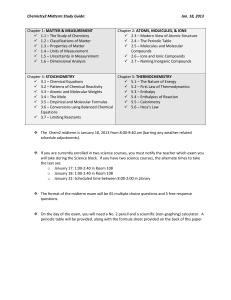
Mass Relationships in
Chemical Reactions
Chapter 3
Copyright © The McGraw-Hill Companies, Inc. Permission required for reproduction or display.
Atomic mass
Atomic mass is the mass of an atom in atomic mass
units (amu). Atomic mass unit is defined as the mass
exactly equal to one-twelfth of the mass of carbon-12 atom.
By definition:
1 atom 12C “weighs” 12 amu
On this scale
Mass of 1 1H atom = 1.008 amu
Mass of 1 16O atom = 16.00 amu
Look at Periodic Table!
3
Li
6.941
Natural lithium is:
7.42%
6Li
(6.015 amu)
92.58% 7Li (7.016 amu)
3.1
Average atomic mass- average mass of naturally
occurring mixture of isotopes.
Natural lithium is:
7.42% 6Li (6.015 amu)
92.58% 7Li (7.016 amu)
Average atomic mass of lithium:
0.0742 x 6.015 + 0.9258 x 7.016 = 6.941 amu
3.1
Average atomic mass (6.941)
Avogadro’s Number and the Molar Mass of an Element
In SI system, the mole (mol) is the amount of a
substance that contains as many elementary
entities as there are atoms in exactly 12.00 grams
of 12C.
1 mol = NA = 6.022 x 1023
Avogadro’s number (NA)
3.2
eggs
Molar mass is the mass of 1 mole of shoes in grams
marbles
atoms
1 mole 12C atoms = 6.022 x 1023 atoms = 12.00 g
1 12C atom = 12.00 amu
1 mole 12C atoms = 12.00 g 12C
1 mole lithium atoms = 6.941 g of Li
For any element
atomic mass (amu) = molar mass (grams)
Atomic mass of Na is 22.99amu and it’s molar
mass is 22.99 g/mol.
3.2
Molecular mass (or molecular weight) is the sum of
the atomic masses (in amu) in a molecule.
1S
SO2
2O
SO2
32.07 amu
+ 2 x 16.00 amu
64.07 amu
For any molecule
molecular mass (amu) = molar mass (grams)
1 molecule SO2 = 64.07 amu
1 mole SO2 = 64.07 g
3.3
Formula mass is the sum of the atomic masses
(in amu) in a formula unit of an ionic compound.
1Na
NaCl
22.99 amu
1Cl + 35.45 amu
NaCl
58.44 amu
For any ionic compound
formula mass (amu) = molar mass (grams)
1 formula unit NaCl = 58.44 amu
1 mole NaCl = 58.44 g NaCl
3.3
Do You Understand Formula Mass?
What is the formula mass of Ca3(PO4)2 ?
1 formula unit of Ca3(PO4)2
3 Ca
3 x 40.08
2P
2 x 30.97
8O
+ 8 x 16.00
310.18 amu
What is the molar mass of Ca3(PO4)2 ?
3.3
Relationship between amu and grams
M = molar mass in g/mol
NA = Avogadro’s number
3.2
Do You Understand Molar Mass?
How many atoms are in 0.551 g of potassium (K) ?
1 mol K = 39.10 g K
1 mol K = 6.022 x 1023 atoms K
1 mol K
6.022 x 1023 atoms K
0.551 g K x
x
=
1 mol K
39.10 g K
8.49 x 1021 atoms K
3.2
Do You Understand Molar Mass?
How many H atoms are in 72.5 g of C3H8O ?
1 mol C3H8O = (3 x 12) + (8 x 1) + 16 = 60 g C3H8O
1 mol C3H8O molecules = 8 mol H atoms
1 mol H = 6.022 x 1023 atoms H
1 mol C3H8O 8 mol H atoms 6.022 x 1023 H atoms
72.5 g C3H8O x
x
x
=
1 mol C3H8O
1 mol H atoms
60 g C3H8O
5.82 x 1024 atoms H
3.3
Percent composition of compounds
Percent composition of an element in a compound =
n x molar mass of element
x 100%
molar mass of compound
n is the number of moles of the element in 1 mole
of the compound
2 x (12.01 g)
x 100% = 52.14%
46.07 g
6 x (1.008 g)
%H =
x 100% = 13.13%
46.07 g
1 x (16.00 g)
%O =
x 100% = 34.73%
46.07 g
%C =
C2H6O
52.14% + 13.13% + 34.73% = 100.0%
3.5
Section 8.6
Percent Composition of Compounds
Exercise
Morphine, derived from opium plants, has the
potential for use and abuse. It’s formula is
C17H19NO3. What percent, by mass, is the carbon
in this compound?
a)
b)
c)
d)
12.0 %
54.8 %
67.9 %
71.6 %
17 12.01
17 12.01 + 19 1.008 + 14.01 + 3 16.00
= 0.716 100 = 71.6% C
Return to TOC
Copyright © Cengage Learning. All rights reserved
14
Section 8.7
Formulas of Compounds
Formulas
•
Empirical formula = CH
Simplest whole-number ratio
•
Molecular formula = (empirical formula)n
[n = integer]
•
Molecular formula = C6H6 = (CH)6
Actual formula of the compound
Return to TOC
Copyright © Cengage Learning. All rights reserved
15
Percent Composition and Empirical Formulas
Determine the empirical formula of a
compound that has the following percent
composition by mass: K 24.75%, Mn
34.77%, O 40.51%.
Assume this compound 100 g, so K 24.75 g,
Mn 34.77g, O 40.51g
nK = 24.75 g K x
1 mol K
= 0.6330 mol K
39.10 g K
1 mol Mn
nMn= 34.77 g Mn x
= 0.6329 mol Mn
54.94 g Mn
nO = 40.51 g O x
1 mol O
= 2.532 mol O
16.00 g O
16
Percent Composition and Empirical Formulas
nK = 0.6330, nMn = 0.6329, nO = 2.532
0.6330 ~
K:
~ 1.0
0.6329
Mn :
0.6329
= 1.0
0.6329
2.532 ~
O:
~ 4.0
0.6329
KMnO4
17
Section 8.8
Calculation of Empirical Formulas
Exercise
The composition of adipic acid is 49.3% C,
6.9% H, and 43.8% O (by mass). What is the
empirical formula?
C3H5O2
Return to TOC
Copyright © Cengage Learning. All rights reserved
18
Section 8.9
Calculation of Molecular Formulas
Exercise
The composition of adipic acid is 49.3% C,
6.9% H, and 43.8% O (by mass). The molar
mass of the compound is about 146 g/mol.
What is the molecular formula?
C6H10O4
Return to TOC
Copyright © Cengage Learning. All rights reserved
19
Chemical Reactions and Chemical Equations
A process in which one or more substances is changed into one
or more new substances is a chemical reaction
A chemical equation uses chemical symbols to show what
happens during a chemical reaction
3 ways of representing the reaction of H2 with O2 to form H2O
reactants
products
3.7
How to “Read” Chemical Equations
2 Mg + O2
2 MgO
2 atoms Mg + 1 molecule O2 makes 2 formula units MgO
2 moles Mg + 1 mole O2 makes 2 moles MgO
48.6 grams Mg + 32.0 grams O2 makes 80.6 g MgO
IS NOT
2 grams Mg + 1 gram O2 makes 2 g MgO
2 MgO(s)
Indicate 2 Mg(s) + O2 (g)
physical
state
2 HgO(s)
O2 (g) + 2Hg(l)
3.7
Balancing Chemical Equations
1. Write the correct formula(s) for the reactants on
the left side and the correct formula(s) for the
product(s) on the right side of the equation.
Ethane reacts with oxygen to form carbon dioxide and water
C2H6 + O2
CO2 + H2O
2. Change the numbers in front of the formulas
(coefficients) to make the number of atoms of
each element the same on both sides of the
equation. Do not change the subscripts.
2C2H6
NOT
C4H12
3.7
Balancing Chemical Equations
3. Start by balancing those elements that appear only once
on each side of the equation and balance them.
C2H6 + O2
2 carbon
on left
C2H6 + O2
6 hydrogen
on left
C2H6 + O2
CO2 + H2O
start with C or H but not O
1 carbon
on right
multiply CO2 by 2
2CO2 + H2O
2 hydrogen
on right
2CO2 + 3H2O
multiply H2O by 3
3.7
Balancing Chemical Equations
4. Balance those elements that appear in two or
more reactants or products.
C2H6 + O2
2 oxygen
on left
2CO2 + 3H2O
multiply O2 by 7
2
4 oxygen + 3 oxygen = 7 oxygen
(3x1)
on right
(2x2)
C2H6 + 7 O2
2
2CO2 + 3H2O
2C2H6 + 7O2
4CO2 + 6H2O
remove fraction
multiply both sides by 2
3.7
Balancing Chemical Equations
5. Check to make sure that you have the same
number of each type of atom on both sides of the
equation.
2C2H6 + 7O2
4CO2 + 6H2O
4 C (2 x 2)
4C
12 H (2 x 6)
12 H (6 x 2)
14 O (7 x 2)
14 O (4 x 2 + 6)
Reactants
4C
12 H
14 O
Products
4C
12 H
14 O
3.7
Amounts of Reactants and Products
1. Write balanced chemical equation
2. Convert quantities of known substances into moles
3. Use coefficients in balanced equation to calculate the
number of moles of the sought quantity
4. Convert moles of sought quantity into desired units
3.8
Methanol burns in air according to the equation
2CH3OH + 3O2
2CO2 + 4H2O
If 209 g of methanol are used up in the combustion,
what mass of water is produced?
grams CH3OH
moles CH3OH
molar mass
CH3OH
209 g CH3OH x
moles H2O
grams H2O
molar mass
coefficients
H2O
chemical equation
4 mol H2O
18.0 g H2O
1 mol CH3OH
=
x
x
32.0 g CH3OH
2 mol CH3OH
1 mol H2O
235 g H2O
3.8
Limiting Reagents
The reactant used up first in a
reaction is called limiting
reagent.
2NO + O2
2NO2
7 mole NO and 8 mole O2
NO is the limiting reagent
O2 is the excess reagent
The maximum amount of
products formed depends
on the amount of the
limiting reagent.
3.9
Do You Understand Limiting Reagents?
In one process, 124 g of Al are reacted with 601 g of Fe2O3
2Al + Fe2O3
Al2O3 + 2Fe
Calculate the mass of Al2O3 formed.
g Al
mol Al
g Fe2O3
124 g Al x
mol Fe2O3 needed
OR
mol Al needed
mol Fe2O3
1 mol Al
27.0 g Al
x
g Fe2O3 needed
1 mol Fe2O3
2 mol Al
Start with 124 g Al
160. g Fe2O3
=
x
1 mol Fe2O3
g Al needed
367 g Fe2O3
need 367 g Fe2O3
Have more Fe2O3 (601 g) so Al is limiting reagent
3.9
Use limiting reagent (Al) to calculate amount of product that
can be formed.
g Al
mol Al
mol Al2O3
2Al + Fe2O3
124 g Al x
1 mol Al
27.0 g Al
x
1 mol Al2O3
2 mol Al
g Al2O3
Al2O3 + 2Fe
102. g Al2O3
=
x
1 mol Al2O3
234 g Al2O3
3.9
Reaction Yield
The amount of the limiting reagent determines
the theoretical yield of the reaction, that is the
amount of product that would result if all the
limiting reagent reacted.
Actual Yield is the amount of product actually obtained
from a reaction.
% Yield =
Actual Yield
x 100
Theoretical Yield
3.10





